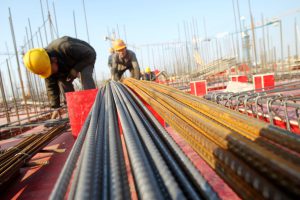China is in the midst of an urban revolution, with millions of migrants moving into cities every year. Since 2011, for the first time in history, more than half of China’s 1.3 billion population (690 million people) are living in cities. Another 300-400 million are expected to be added to China's cities in the next 15-20 years. New Premier Li Keqiang recently proposed accelerating urbanisation in China and said it was the “main driver” of China’s future economic growth.
Yet, China’s urban dream may be derailed by the lack of affordable housing in cities for the existing urban poor and the massive influx of migrants.
Until the 1990s, Chinese cities were dominated by welfare-oriented public rental housing provided by either the government or public employers. Severe housing shortages, residential crowding, and poor housing conditions were common problems in cities. Over the last two decades, Chinese cities have experienced an unprecedented housing privatisation, as the Chinese government has sold public rental housing at deeply discounted prices, encouraged developers to provide new private housing and ended public housing provisions.
With the influx of both domestic and international investment, there has been an unprecedented housing boom in Chinese cities. Between 2000 and 2010, according to the Economist Intelligence Unit, China constructed roughly twice the total number of houses in the UK, or about the same amount of houses that are in Japan.
As a result, housing conditions in Chinese cities has improved significantly. Residential floor space per capita in cities increased from 43 square foot in 1980 to 340 square foot in 2010, although this is still much smaller than in the US (700 square foot per person). Three-quarters of households in cities/towns (85% of all households nationwide) were homeowners in 2010, compared to about 20% in the 1980s. Even though some apartments are owned with partial property rights due to subsidies, the rate of homeownership in China is much higher than in many developed countries. For example, the comparable figure in the US is just 65%.
Unaffordable house prices
Meanwhile, house prices have skyrocketed in cities, with the national average house price increasing by 250% in the decade between 2000 and 2010. The house price-income ratio classifies much of China as “severely unaffordable”. In big cities like Beijing and Shanghai, a modest apartment can cost multiple millions of yuan to purchase, and thousands of yuan to rent, making housing affordability the top concern of most low- and middle- income households.
According to the latest 2010 census, there were still about 17% of urban family households living with “housing difficulty”, defined by the government as less than 13 metres square living space per person. This measure did not even include those with the worst housing condition, often people living in dorms in so-called “collective households”. With the lack of affordable housing, the urban poor has to live in unconventional, illegal housing, such as dorms in basements and bomb shelters (tenants are called “mouse tribe”, shu zhu), abandoned containers, roof top apartments, make-shift rooms, group rented apartments, and rooms in suburban villages, forming various types of slum-like communities.
In addition to the typical urban poor such as migrants and the old/sick/disabled urban residents, college graduates and young professionals cannot afford decent housing in big cities either. For example, in Beijing, tens of thousands of college graduates live in cramped, boxy rooms in Tangjialing, a dusty village outside of Beijing, and spend hours commuting to work each day (known as “ant tribe”, yi zu).
Meanwhile, there are many “ghost cities”, with a large number of brand new apartments unoccupied. Yet these “empty” apartments are not for the urban poor. With few investment options, the lack of property tax, and ever rising house prices, the middle- and upper- class have plunged into speculative house purchases. Developers have focused on upscale housing for sale with high profit margins, instead of affordable housing for rent. The rate of second homeownership in China is higher than that in many developed countries.
Faced with increasing discontent and potential social instability, the central government has renewed its commitment to low-income housing in recent years, pumping billions of yuan into the low-income housing development and setting ambitious targets. The year 2010 marked a turning point, with the building of 5.9 million units of subsidised housing, of which 3.7 million units were basically completed by the end of the year. Another 36 million units of subsidised housing has been planned between 2011 and 2015. The goal is to cover 20% of urban households with subsidised housing, and low-income households should enjoy at least 13 metres square per capita floor space by 2015.
While these targets are encouraging, the implementation of these housing targets is still to be seen. There have been reports about local governments relabeling existing housing as new affordable housing to meet the target, as well as affordable housing being poorly constructed, located in remote places with poor services, thus unattractive to low income households. To make things worse, subsidised housing, especially places in good locations and of good quality, often ends up in the hands of undeserving households such as middle class households working for large universities, ministries, and other government agencies, who often own multiple homes.
Migrants left out of the Chinese dream
What's more, these new efforts focus mainly on the poor with urban household registration, while millions of poor migrants are still not the policy's target. With the discriminatory Household Registration System, or hukou system (often called an internal passport system), migrants are not considered "legal" residents despite their living and working in cities long term, and they are not entitled to welfare benefits such as subsidised housing.
Even in Shenzhen, a city of migrants, a local hukou is required to access low-income housing. In others cities like Beijing, several years of local hukou is required before applying for low-income housing. Any low-income housing policy leaving out such a large segment of the poor as migrants defies the ultimate purpose of low-income housing policy – social justice, and thus is a failed one.
Due to this institutional exclusion, as well as their generally low socioeconomic status, millions of migrants have been completely left out of the "Chinese Dream" of a decent home for all. Without government subsidies, even just renting a decent apartment in the formal market is beyond most migrants' means, let alone purchasing one. As a result, most migrants are forced to find temporary housing such as factory dorms, basements, and illegal housing built by suburban villagers.
In particular, suburban villages have been the largest provider of affordable housing for migrants forming so called "migrant enclaves". Around 50% of migrants in the Pearl River Delta live in rental housing in suburban villages; in Shenzhen 48% of all housing in the city belongs to original village residents. Because these "migrant enclaves" are technically illegal, and therefore could be demolished by the government at any time, they are often of extremely poor quality and built with the sole aim of maximising the amount of occupants they can house. Thus, migrants are forced to live in slum-like settlements at the fringe of urban society.
With rapid urbanisation/urban renewal and the government's pursuit of modernity, the limited affordable housing for migrants is under threat, with migrant enclaves being demolished/redeveloped, basements being evacuated, and old neighborhoods being gentrified. An unprecedented challenge facing the Chinese government is finding a way to shelter the massive numbers of migrants currently living in Chinese cities, as well as those who will arrive in the coming years.
The government response
So far the government's efforts have been lacking. In 2010 the Ministry of Housing and Urban Rural Development (MOHURD) suggested that the latest rent controlled housing – Public Rental Housing (gong zu fang) – may be accessed by qualified migrants. Yet, strict qualifications make it accessible only to a very small proportion of skilled migrants, leaving the majority of migrants in the same boat as before.
So long as one-third of urban residents are migrants without legal resident rights, urbanisation in China will remain "incomplete". To succeed, the Chinese government must make affordable housing for migrants and the growing urban population a top priority.
The central government has to ensure local governments' commitment to migrant housing through both profound reforms and financial incentives. For example, the public finance system should be reformed to allow local governments to keep a larger share of their budgetary revenue and diversify their revenue sources with more long-term, stable tax revenues replacing the lump-sum land-based revenues.
At the same time, the central and the local government should work together to mobilise developers, employers and urban villages to provide affordable housing through incentives such as low-interest loans, cheap land and tax breaks, and reforms in the land and housing system.
In particular, the government should fully recognise suburban villagers’ land rights, and allow their collectively owned land to enter the land and housing market directly. With the existing dual land system in China, only local municipal governments can convert rural land into urban land for urban development. This monopolised rural-urban land conversion by the local government needs to be abolished, and housing provision by urban villages should be legalised/formalised.
In addition, as most industrial land is not used very intensively in China, employers should be encouraged to use vacant industrial land for housing development where appropriate; and developers should be required to provide affordable housing to migrants and other urban poor through inclusionary housing.
These reforms will result in a large supply of decent, affordable housing in both the public and private sector. Only then will millions of migrants achieve their housing dream in cities.






